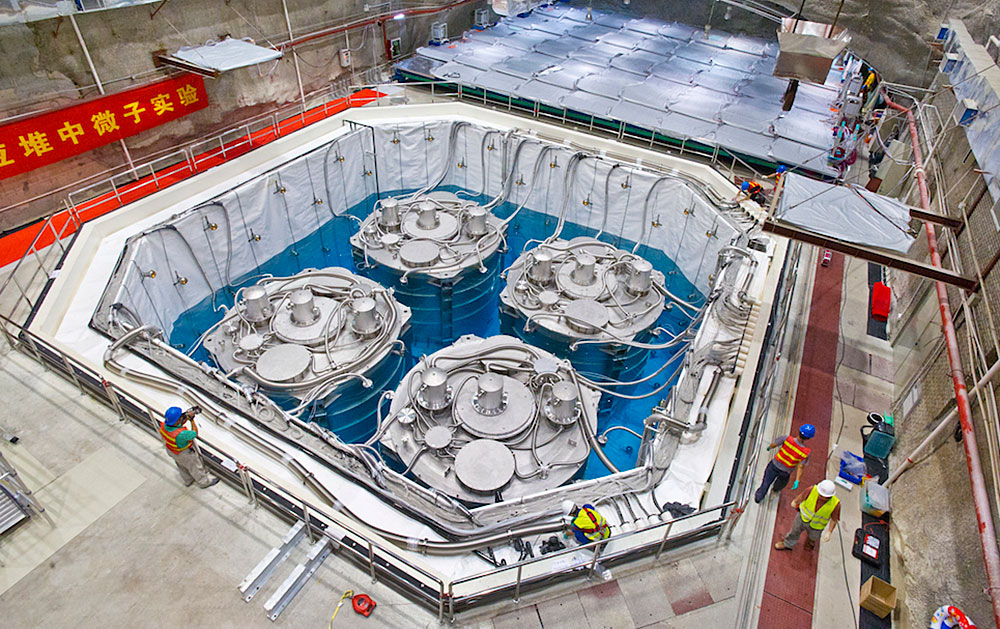European Physical Society Honors Daya Bay Collaboration
Brookhaven Lab played key roles in measurement that paves the way for detection of matter-antimatter asymmetry
August 24, 2023
 enlarge
enlarge
Bird's-eye view of the underground Daya Bay far detector hall during installation. The four antineutrino detectors are immersed in a large pool filled with ultra-pure water. (Credit: Roy Kaltschmidt, Berkeley Lab)
UPTON, NY—The Daya Bay Reactor Neutrino Experiment collaboration, an international team of researchers measuring key properties of ghostlike particles called neutrinos, is a co-recipient of the European Physical Society’s (EPS) 2023 High Energy and Particle Physics Prize. Physicists and engineers from the U.S. Department of Energy's Brookhaven National Laboratory have played key roles in this project.
The award specifically recognizes the collaboration’s “observation of short-baseline reactor electron-antineutrino disappearance, which provides the first determination of the neutrino mixing angle theta13 and paves the way for the detection of charge parity (CP) violation in the lepton sector.”
The Reactor Experiment for Neutrino Oscillation (RENO) in South Korea and Cecilia Jarlskog, a theorist at Sweden’s Lund University, are co-recipients of the prize. The scientists were honored at the EPS Conference on High Energy Physics, August 21-25, 2023.
“It is quite an honor for Daya Bay’s experimental achievement to be acknowledged alongside Professor Cecilia Jarlskog, who discovered an invariant measure to quantify CP violation in both the lepton and quark sectors,” remarked Brookhaven Lab physicist David Jaffe of the Daya Bay collaboration.
The first analysis of the Daya Bay experiment’s final data set, announced last year, revealed the most precise measurement yet of theta13, a key parameter for understanding how neutrinos change their “flavor” among three known types.
The results come from measurements of electron-antineutrinos at the Daya Bay experiment in Guangdong, China. The experiment consists of eight large, cylindrical particle detectors immersed in pools of water in three underground caverns. The detectors pick up light signals generated by antineutrinos streaming from nearby nuclear power plants. Two caverns are near the nuclear reactors and the third cavern is farther away, providing ample distance for the electron-antineutrinos emitted from the reactors to oscillate, or change into one of the two other neutrino flavors, as they travel. Counting how many electron-antineutrinos “disappear” thus allows scientists to calculate theta13, one of the so-called mixing angles that dictates the probability of these oscillations.
Brookhaven Lab scientists and engineers led the Daya Bay collaboration’s detector engineering and design efforts. They perfected the “recipe” for the chemically stable liquid scintillator that fills the experiment’s particle detectors where the antineutrinos interact. They also developed software and analysis techniques for measuring neutrino oscillations and play ongoing roles in project management and data analysis.
The Daya Bay collaboration’s precision measurement of theta13 will enable physicists to more easily measure other parameters in neutrino physics, as well as develop more accurate models of subatomic particles and how they interact.
For example, the findings could pave the way for determining whether there are subtle differences between neutrinos and antineutrinos, their antimatter twins. Scientists believe such a difference between matter and antimatter—more technically known as a violation of CP symmetry—must exist to explain why our universe today is dominated by matter with very little antimatter to be found. If there were no difference, equal parts of these opposites created in the Big Bang would have annihilated one another, leaving nothing but light behind. But here we are, made of matter, able to ponder this mystery and design experiments to try to solve it.
“DUNE, the Deep Underground Neutrino Experiment, will exploit Daya Bay’s groundbreaking work to provide deep insights into CP violation with precision measurements of neutrinos and antineutrinos,” said Steve Kettell of Brookhaven Lab, U.S. chief scientist for Daya Bay.
Brookhaven National Laboratory is supported by the Office of Science of the U.S. Department of Energy. The Office of Science is the single largest supporter of basic research in the physical sciences in the United States and is working to address some of the most pressing challenges of our time. For more information, visit science.energy.gov.
Follow @BrookhavenLab on social media. Find us on Instagram, LinkedIn, Twitter, and Facebook.
2023-21411 | INT/EXT | Newsroom









